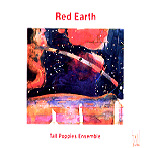Listeners looking for a happy adventure into some of the last century’s less-traveled musical territory–that is, works by Australian composers–are advised to investigate this excellent program of chamber works. And although all of these pieces were written in the 1980s or before (one is from 1948), they remain remarkably fresh-sounding and are surprisingly free of the faddish experimentation or anti-audience hyper-technical mannerisms rampant in the compositional world back then. Instead, we get music that’s not only readily listenable but smart, capable of holding our interest because in each work there’s a perceivable progression of events–rhythmic, melodic, timbral, dynamic–that both orient us and keep us in anticipation. And, each composer uses his instrumental forces–varying combinations of flute (or piccolo), clarinet, violin, viola, cello, bassoon, piano, and percussion–creatively and intelligently.
That’s not to say that every piece is a winner–or necessarily one you’d want to hear repeatedly. However, the program itself is very well-conceived and ordered to draw us willingly through the whole thing at a sitting–thanks to the uniqueness of each piece and to the first-rate musicianship, both individual and ensemble. Colin Bright’s Red Earth is supposed to be an exploration of “the psyche of place”–specifically the Australian outback–and indeed several other of the works here purport to have their own extra-musical agendas or provenances. Putting my own skepticism aside regarding the nature and purpose of such representations, I will say that the piece succeeds because of its exciting rhythmic framework (rapid-fire repeated notes, changing meters, starts and stops) and for its constantly shifting instrumental combinations and brazen harmonies. A slower, reflective middle section keeps threatening to break loose in a return to the opening fury–and it never does (but probably should have). Nevertheless, this is a worthy and very enjoyable effort. Peggy Glanville-Hicks’ Concertino is a sunny, optimistic work for piano and winds that dances along through three very well-structured movements. The expert scoring (and the terrific piano part) make this one of the disc’s most engaging entries–and yes, it’s the most traditionally-oriented of the six works.
Most reminiscent of those 1970s and ’80s conservatory-style exercises is David Lumsdaine’s Bagatelles. Except for the opening solo-violin rumination, most of the eight sections sound disjointed (intentionally so?), sometimes sputtering and spitting odd bits of melody, at others attempting to actually develop an idea. Neil Currie’s Ortigas Avenue is a springy, jazzy (if somewhat repetitive) reflection on the fall of the Marcos regime in the Philippines in February, 1986. Although you’re unlikely to hear the connection, the music’s inherently snappy style will keep you engaged–perhaps even moving your feet. Ross Edwards’ Shadow D Zone (we’re never told what this means) just lies there, barely moving, perhaps invoking a nearly deserted landscape where every discernible feature, no matter how small or what color or how soft, is of major significance. Nine minutes may be a little too much for this concept, but try closing your eyes as you listen–you may begin to think more of the Twilight Zone than of the work’s own title.
Finally, Vincent Plush’s On shooting stars, which also carries an extra-musical theme–a tribute to Chilean folksinger-poet Victor Jara–is less a unified work and more a series of three “scenes” stuck together with some interesting percussion writing (including for the piano) and effective dramatic moments that portray “the chaos and panic” during the coup against Salvador Allende in 1973. Overall, the recorded sound is very good and as mentioned, the quality of the playing is uniformly excellent. No, this may not be for everyone, but most listeners–even those who tend to shy away from latter-20th-century chamber music–will find delights and rewards here enough to make this a worthwhile acquisition. [8/2/2004]
































